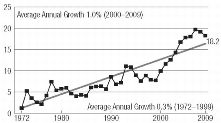We use a single indicator called total factor productivity (TFP) to measure productivity. TFP measures the change in the relationship between outputs (workload processed) and inputs (resource usage). Workload consists of weighted mail volume, miscellaneous output and our expanding delivery network. Resources consist of labor, materials (including transportation) and deployed capital assets. Workload minus resources used equals TFP.
During 2009, TFP declined 0.9%. This marks the second consecutive year that the Postal Service registered a decline in annual TFP. Prior to 2008, the Postal Service had eight straight years of TFP growth. In spite of a record reduction of 115 million workhours, efforts to utilize material such as supplies and services efficiently, and efforts to maximize the return on capital investments, mainly automation, we were unable to completely offset the 12.7% drop in mail volume resulting from the poor condition of the economy.
Aggregate workload for 2009 declined 8.3%. This was mainly due to a sharp decline in weighted mail volume, driven by the 10.5% decline in First-Class single-piece mail volume. In response to the workload decrease, we reduced resource usage 7.4% compared to last year. Labor usage, in particular, fell 7.9%.
During 2008, TFP declined 0.5%, the first year since 1999 that the Postal Service registered a decline in annual TFP. Despite efforts to manage workforce utilization (reduction of 50 million workhours), utilize material such as supplies and services efficiently, and maximize the return on capital investments (mainly automation), the worsening conditions across most sectors of the U.S. economy during this fiscal year, resulted in a 4.5% decline in mail volume, which we were unable to completely offset.
The following graph shows the cumulative TFP trend from 1972 through 2009.
Average Annual Growth (percentage)

